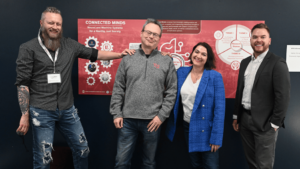Connected Minds has just completed its second year of funding, marked by a highly successful annual retreat. As we enter Year 3 of the program, I would like to take a moment to reflect on some of the key achievements and developments at Queen’s University over the past year. Following an initial year focused on establishing the program’s foundations and engaging the broader community, we have now transitioned into a period of active growth – advancing interdisciplinary research, training the next generation of researchers, and fostering meaningful knowledge exchange.
We are beginning to see the transformative potential of the Connected Minds vision: to re-envision the relationship between humanity and technology in ways that are innovative, inclusive, and impactful.
Building a Shared Vision for Interdisciplinary Collaboration
One of the most rewarding developments this year has been the clear alignment among our investigators and trainees with the core values and interdisciplinary mission of Connected Minds. What began as a broad, ambitious framework is now taking shape as a dynamic, collaborative research environment. Across the Queen’s community, there is a growing sense of cohesion and purpose. Investigators and trainees alike are engaging deeply with the program’s goals – including engagement with Indigenous communities and their research priorities, advancement of equity, diversity and inclusion initiatives, and exploration of promising intersections between neural and technological research areas.
At this year’s retreat, this collective energy was evident. Collaborative projects, cross-disciplinary dialogue, and the emergence of new research partnerships are now a regular feature of the Queen’s Connected Minds network. This development marks an exciting turning point from building foundations to establishing momentum.
Enhancing Training and Mentorship
At Queen’s, Connected Minds has significantly expanded research training opportunities. Currently, the program supports 8 MSc students, 11 PhD candidates, and 7 postdoctoral researchers. Their projects span a wide array of topics, including spiking neural networks for prosthetic control, human-robot interaction, responsible neurotechnology innovation, and the use of AI in healthcare and Indigenous knowledge preservation.
Trainees had the opportunity to present their work at the annual retreat, and the level of sophistication and ambition on display was truly impressive. We look forward to following their research journeys in the years to come.
To support community-building and professional development among trainees, we have launched a series of monthly coffee hours. These events go beyond informal discussion to include lab visits and hands-on, workshop-style learning – fostering both intellectual exchange and a sense of shared purpose.We continue to develop our flagship microcredentials program in neurotechnologies. This year, Connected Minds is supporting the development of three new courses: Understanding Brain-Computer Interfaces (BCIs), Ethical, Legal, and Societal Implications of BCIs, and Neuromodulation in Psychiatry and Neurology.
A highlight of the past year has been our continued support for the STEMInA program, providing exceptional Indigenous students with research opportunities and mentorship. The program reflects our commitment to inclusiveness, research excellence and community engagement, and we are proud of its success. I encourage everyone to engage with the program. Being part of it is a wonderful experience and learning opportunity.
Advancing Research and Innovation
Queen’s is playing an active leadership role within Connected Minds, with numerous research initiatives aimed at transforming healthcare and advancing our understanding of brain-machine interfaces. Our research community is tackling some of the most pressing challenges at the intersection of neuroscience, AI, and digital health – from predictive analytics and remote patient monitoring to accessible health systems and personalized care.
This work is supported by a robust network of funding mechanisms, including Seed Grants, Prototyping Grants, Knowledge Mobilization Grants, and dedicated support for trainees. Larger Team Grants are also on the horizon. Complementing these mechanisms, we continue to host collaborative events such as retreats, symposia, and co-creation workshops to foster new ideas and catalyze innovation.
Programmatic Leadership and Outreach
The Queen’s Connected Minds team has also taken a leading role in developing program-wide initiatives that help bring the vision of Connected Minds to life. This includes launching the first community-wide newsletter, hosting a regular Connected Minds seminar series, and establishing a new Connected Minds Blog. We have also formed a partnership with the Think Twice: Queen’s Neuroscience Podcast to produce episodes focused on Connected Minds themes.
Beyond the university, we are proud to support public-facing initiatives such as the Festival of Live Digital Arts (FOLDA) and Brain Reach – an elementary school outreach program. These efforts are essential to our broader mission: ensuring that the insights and innovations generated within the program reach diverse audiences and help shape a more equitable, connected, and inclusive technological future.
As we move into the third year of Connected Minds, the Queen’s community is energized by the progress we’ve made and excited about what lies ahead. We are proud to contribute to a program that is not only advancing science and technology but also reimagining the ways these fields can serve society.



